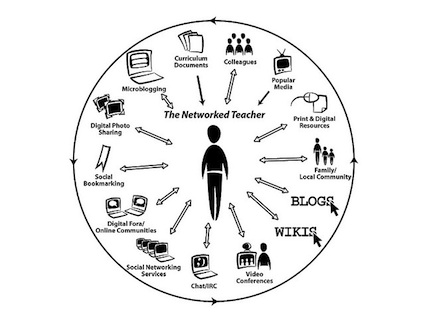Professor Alec Couros: "The Connected Teacher"

One powerful benefit of networked learning is that when you find something interesting, it often leads to someone interesting – and that someone often leads to entire networks of interesting people. Or, as Dr. Alec Couros puts it, “the tools come and go, but the relationships endure.” I found Professor Couros the way many people did, by coming across the intriguing diagram of "The Networked Teacher” that many educators now use in their slide presentations. 
By the time I discovered Dr. Couros, now professor of educational technology and media at the University of Regina, I had already learned about the cultivation of personal learning networks, so I followed him on Twitter and learned quickly that it is always worth my time to click through to one of his publications.
The “Networked Teacher” diagram, I soon learned, was emblematic of Couros’ devotion to open education “influenced by the ideals of the Open Source Software movement and the progression towards other forms of openness (e.g., open content, open access).” And I discovered that the graphic is an illustration for Couros’ dissertation, which he put online (under a Creative Commons license, naturally). He’s hardly the first person to publish his thesis online, but very few dissertations are accessed 28,000 times.
Couros lives by the principles he blogs. Publishing your dissertation is no big deal. How about publishing your entire application for tenure as a digital portolio, describing your “life as a teacher and scholar within a vast, global learning network?” (He got tenure.)
I was intrigued by the simplicity and power of a simple learning assignment Couros had adapted from his friend and colleague, Dean Shareski, which he called “The Learning Project":
1. Learn a skill, concept or idea you know very little or nothing about but that you're interested in learning.
2. Document the learning. Write about it, video tape, audio record, whatever.
3. Consider all the sources you use to learn. Collect those resources.
4. Take an early baseline snapshot of your understand at the beginning and another one at the end. Compare and analyze.
In my video interview with Couros, we get into details about making learning visible and see how one student learned to make mukluks, created a blog post and video to describe her learning, and reflected on her learning process while another student created a Mario Brothers-like video game to summarize his learning and made a video showing how he made the game and why. If you are interested not just in the power of networked digital technology, but the power of learning that is both reflective and networked, Couros and his students are worth your attention.
Professor Alec Couros: "The Connected Teacher" from DML Research Hub on Vimeo.
Banner image credit: Lawrence Berkeley National Laboratory http://www.flickr.com/photos/berkeleylab/4863700123/in/photostream/